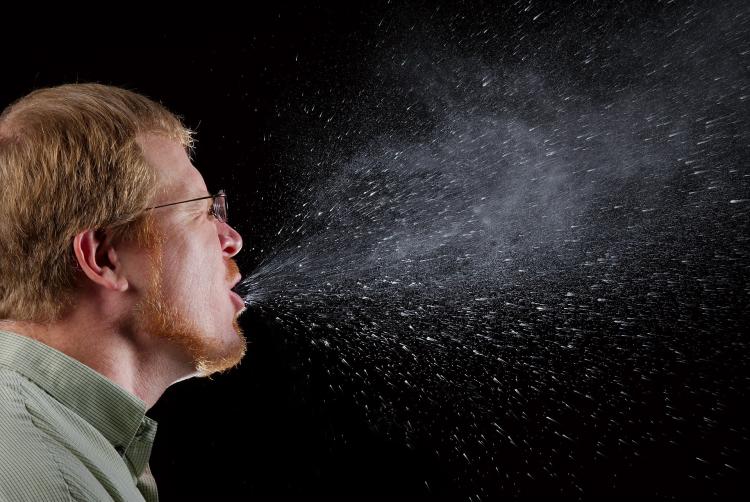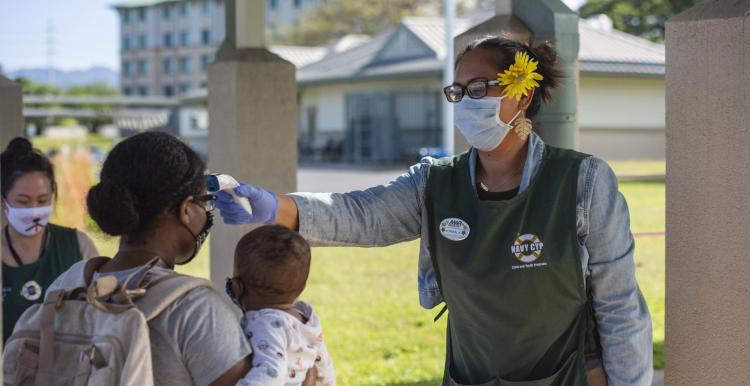Experts weigh in on airborne transmission of COVID-19
The novel coronavirus may be able to travel from person to person through tiny particles floating in the air, according to a recent letter signed by 239 scientists from across the globe.
The international team, which includes six faculty members from CU Boulder, lays out evidence showing just how tenacious the pathogen behind COVID-19 can be: The virus, the group says, can likely drift through and survive in the air, especially in crowded, indoor spaces with poor ventilation like many bars and restaurants.
“Once droplets carrying the virus become small enough, they can stay in the air for minutes or even hours, and we can breathe them in during that time if we are in the same room,” said Jose-Luis Jimenez, a professor in the Department of Chemistry and a fellow in the Cooperative Institute for Research in Environmental Sciences (CIRES).
Jimenez and others who signed the July 6 letter may already be having an impact: On July 9, the World Health Organization (WHO) updated its guidance around how COVID-19 might spread, recognizing that airborne pathways may play a role.
The global health body had, for months, resisted the idea of an airborne coronavirus. Instead, the WHO focused on the risks of the virus spreading through heavy, liquid droplets and on doorknobs and other surfaces.
CU Boulder’s Shelly Miller, who also signed the letter, says it’s about time.


Top: Scientists have long agreed that large drops of liquid, such as those produced during a sneeze, can transmit the coronavirus. Emerging research, however, suggests that invisible "microdroplets" may also spread infection. Bottom: A woman conducts temperature checks at Joint Base Pearl Harbor-Hickam in Hawaii. (Credits: CDC/U.S. Navy)
She and Jimenez have also been working closely with campus officials as they prepare to welcome students, faculty and staff back to CU Boulder this fall.
“More than 200 scientists from different disciplines and from around the world read our letter, and overwhelmingly agreed to sign on,” said Miller, a professor in the Environmental Engineering Program and the Paul M. Rady Department of Mechanical Engineering.
“That’s a powerful statement.”
Tiny drops
Jimenez has worked to predict how infection can spread when people exhale virus particles in indoor spaces. He’s quick to point out that Americans should continue to follow the same steps to avoid getting sick from the coronavirus: wear a mask, avoid crowds and stay outside if possible.
But a new understanding of how the coronavirus spreads may also lead to better strategies for slowing the pandemic, including improving ventilation and installing indoor air filters.
“We don’t want to undermine the WHO,” Jimenez said. “We believe they have a critical role to play, which is why it’s very important that they change their guidance.”
The effort originally emerged from a letter sent to the WHO by a core group of 36 scientists, including Jimenez and Miller. The researchers later published their letter in the journal Clinical Infectious Diseases with signatures from more than 200 other scientists. Lidia Morawska of Queensland University of Technology in Australia led the campaign.
The debate, Jimenez explained, largely comes down to size. Everyone agrees that the coronavirus can spread through large drops of liquid (think of the spray that flies out of your mouth when you sneeze).
Where Jimenez and his colleagues and the WHO disagreed, at least until recently, came down to much smaller beads of moisture. These “microdroplets” are too tiny to see with the naked eye. But humans can expel them when they sing, talk or even just breathe—no sneezing required.
Could such invisible spittle also help to transport the coronavirus? Several recent studies have explored that very question. They included studies of COVID-19 “superspreading” events, lab experiments with small animals and surveys of the air in hospital rooms and other indoor spaces.
And according to the letter writers, the answer is "yes," at least under certain conditions.
“You have to help the disease by being indoors for a long time without masks on and in crowded conditions, and with low ventilation. Shouting or singing also helps,” Jimenez said. “It’s similar to what we’ve seen happening in bars and restaurants in places like Texas.”
Cool breezes
A growing body of research also points to one more important factor in the transmission of the coronavirus: ventilation.
In her own research, Miller has tried to recreate the path the coronavirus took in one famous outbreak—a case in which 53 choral singers came down with COVID-19 after a practice session in a church in Skagit County, Washington.
Her findings are still undergoing peer review, but Miller said that more air flow likely could have helped the singers—in addition to spending less time in practice. Fresh breezes coming in from the outside can clear droplets laden with the virus from indoor areas, potentially lowering the risk to those inside.
“We need as much outside air as possible,” Miller said. “If you have to recirculate air, then use the highest rated filter that you can.”
Airborne or no, people may be the biggest factor in deciding how long the COVID-19 pandemic lasts. A few precautions, Miller said, can go a long way.
“I hope the general public can understand that this is isn’t about politics or taking away your freedoms,” she said. “It’s about giving you the freedom to be able to go out and eat at a restaurant and shop and do what you love doing—but in a healthy way.”
Other CU Boulder signatories included Mike Hannigan, professor of mechanical engineering, Daven Henze, associate professor of mechanical engineering, Margaret Tolbert, distinguished professor of chemistry, and Zhiqiang (John) Zhai, professor of civil, environmental and architectural engineering.


